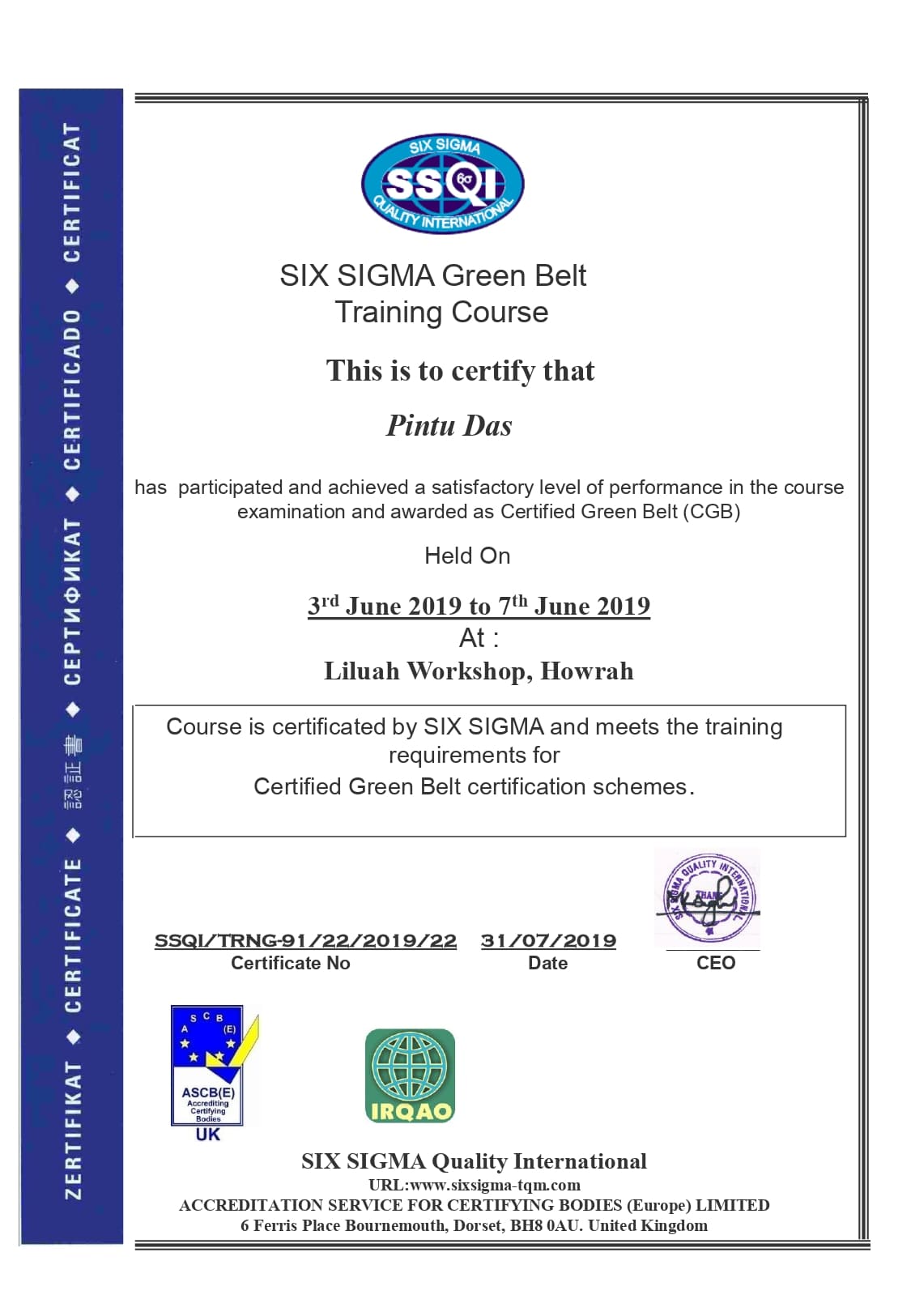Sale!
Six Sigma Green Belt Certification Program
Original price was: ₹15,000.00.₹12,000.00Current price is: ₹12,000.00.
The Six Sigma Green Belt Certification Program is a training and certification course designed to teach participants the principles and methodologies of Six Sigma. Six Sigma is a set of techniques and tools for process improvement that aims to reduce defects and variability in processes to improve quality and efficiency.
Here’s an overview of what you can expect from a Six Sigma Green Belt Certification Program:
### Objectives:
1. **Understanding Six Sigma Principles**: Learn the basic concepts, principles, and philosophy of Six Sigma.
2. **DMAIC Methodology**: Gain proficiency in the DMAIC (Define, Measure, Analyze, Improve, Control) process, which is the core methodology of Six Sigma.
3. **Tools and Techniques**: Learn various Six Sigma tools and techniques such as process mapping, statistical analysis, root cause analysis, and more.
4. **Project Management**: Understand how to manage and lead Six Sigma projects from start to finish.
5. **Teamwork and Collaboration**: Develop skills in teamwork, collaboration, and effective communication to work with cross-functional teams.
6. **Data-Driven Decision Making**: Learn how to make informed decisions based on data and statistical analysis.
7. **Problem-Solving Skills**: Enhance your problem-solving skills to identify, analyze, and solve process problems effectively.
### Course Content:
1. **Introduction to Six Sigma**
– History and evolution of Six Sigma
– Six Sigma roles and responsibilities
2. **Six Sigma Principles and Philosophy**
– Customer focus
– Process improvement
– Data-driven decision making
3. **DMAIC Methodology**
– Define: Project charter, voice of the customer
– Measure: Data collection, measurement system analysis
– Analyze: Root cause analysis, hypothesis testing
– Improve: Solution implementation, pilot testing
– Control: Control plans, monitoring and sustaining improvements
4. **Six Sigma Tools and Techniques**
– Process mapping
– Statistical analysis (e.g., control charts, histograms)
– Root cause analysis (e.g., fishbone diagram, 5 Whys)
– Failure mode and effects analysis (FMEA)
– Design of experiments (DOE)
5. **Project Management and Leadership**
– Project selection and scoping
– Project planning and scheduling
– Team leadership and motivation
6. **Teamwork and Communication Skills**
– Team dynamics
– Effective communication
– Conflict resolution
### Certification Requirements:
To earn a Six Sigma Green Belt Certification, participants usually need to:
1. **Complete Training**: Attend and successfully complete the Green Belt training program.
2. **Pass the Exam**: Pass a certification exam that tests knowledge and understanding of Six Sigma principles, DMAIC methodology, and other related topics.
3. **Complete a Project**: Successfully complete a Six Sigma project using the DMAIC methodology and demonstrate the application of Six Sigma tools and techniques.
4. **Experience**: Some programs may require a certain amount of practical experience or involvement in Six Sigma projects.
### Benefits of Six Sigma Green Belt Certification:
1. **Career Advancement**: Enhance your career opportunities and potential for promotions in quality management, operations, and other related fields.
2. **Skill Development**: Develop valuable skills in process improvement, problem-solving, data analysis, and project management.
3. **Organizational Impact**: Contribute to organizational success by improving processes, reducing defects, and increasing customer satisfaction.
4. **Professional Recognition**: Gain recognition and credibility as a certified Six Sigma professional, demonstrating your commitment to quality and excellence.
Overall, the Six Sigma Green Belt Certification Program provides a comprehensive training experience that equips participants with the knowledge, skills, and tools needed to effectively lead Six Sigma projects and drive continuous improvement within organizations.


Reviews
There are no reviews yet.